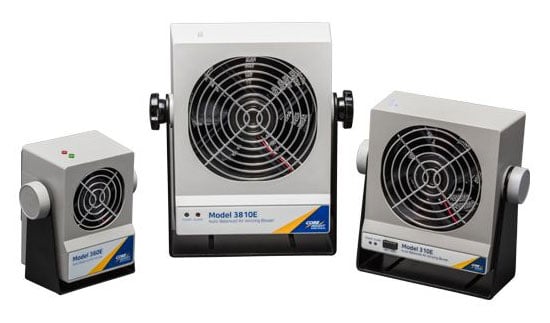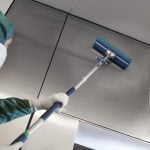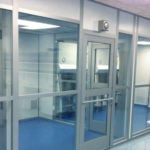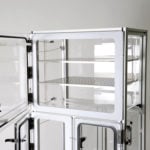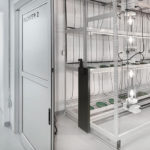What equipment in your manufacturing environment is maintenance free? The answer is simple: none.
As with all other equipment, ionizers used for static charge and contamination control need an established maintenance process. Ionizers using corona discharge technology need their emitter points cleaned and their ionizer balance calibrated. When these maintenance needs aren’t performed periodically, corona emitter points will become dirty, shed particles that may damage products, and won’t be able to control static charge.
Corona ionizers use high voltage on sharp emitter points to create electric fields needed to produce positive and negative ions in the gases in the air. The high electric field also attracts small particles to the ionizer and interacts with the chemicals in the factory air. This results in particle buildup on both the emitter points and the body of the ionizer. This buildup will alter the ionizer’s performance, decreasing the ion output and changing the ionizer’s balance. Neither effect is desirable when working with sensitive electronic products that need to be protected from electrostatic discharge.
These are not the only problems a lack of ionizer maintenance can cause. The particles collecting on the ionizer and its emitter points can detach and land on products during the manufacturing process. This can cause lower product yields in cleanrooms and other manufacturing areas.
When you decide to use ionizers as part of your static control program, you must establish an appropriate maintenance process to ensure their long-term operation. Corona ionizers will require periodic cleaning to remove particles that are attracted and prevent them from being deposited back onto products. Particles on the emitter points and the eventual erosion of the emitter points will affect both ionizer charge neutralization and ionizer balance. These can be serious problems, particularly when ESD-sensitive products must be protected.
Here are some visible results of the lack of ionizer maintenance:
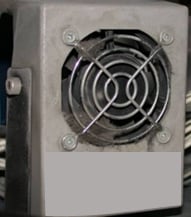
Ionizer in need of cleaning. 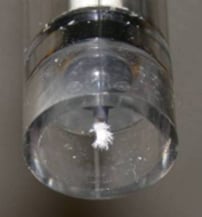
Buildup of a “fuzzball” on the emitter tip. 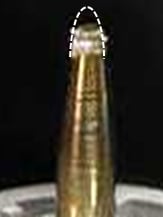
Effects of particle collection and emitter point erosion.
Issues Stemming from Poorly Maintained Ionizers
The need for ionizer maintenance arises from three basic issues: particle attraction, particle shedding, and ionizer electrical performance.
Particle Attraction. Particle attraction results from both the electric field of the ionizer and the ions themselves interacting with the gases and particles in the air. Ions released into the air will attach to dust particles, causing them to become charged. These charged dust particles will be attracted to the ionizer ( see Figure 1).
“Fuzzball” Buildup. High electric fields at the emitter point will cause gas-to-particle conversions at the emitter point. This results in the buildup of fuzzballs (see Figure 2).
Erosion. Gas molecules impinging on the emitter points because of the field attraction will erode ( see Figure 3).
Once on the body of the ionizer or the emitter points, particles may dislodge by a slight motion of the ionizer or airflow. Particle shedding can impact product quality and yields.
Maintaining Ionizers in Electronics Assembly Environments
In electronic assembly environments, the goal of ionizer maintenance is to maintain ionizer performance, both for optimal discharge time and ionizer balance. Particle production by ionizers is less of an issue, although particles falling on a product may cause appearance rejects.
After installing the ionizers, check their performance with the industry’s standard testing method using a Charged Plate Monitor (CPM). The worldwide ionization standard, ANSI/ESD STM3.1, lists test instructions. A more convenient method of checking large numbers of ionizers is available using portable instruments. This method of testing ionizers is called a Periodic Verification System (PVS) and is described in the industry standard ANSI/ESD SP3.3.
Using either of these two methods will provide information to ensure the ionizers are working and continue to work as intended.
Some ionizers will include circuitry and alarms to show when maintenance is needed. Most ionizers, however, do not have these alarms and often end up looking like the ionizer shown in image 1. A useful alternative for fan-type corona ionizer is an automatic emitter point cleaner (see Figure 4). These cleaners only require that you turn the ionizer off until the fan stops and then turn it back on. The cleaning process only occurs when the fan speed is below its operating level. Some fan-type ionizers have a programmable cleaning cycle that can be set to clean automatically.

Maintaining Ionizers in Cleanroom Environments
Maintenance of ionizers used in cleanrooms must address both ionizer performance and particles produced by ionizers. There are far fewer particles present in cleanroom environments, but people, the manufacturing process, and equipment still produce them. Ionizers remove static charge from products, reducing the number of particles that are attracted to product surfaces. Ionizers also produce particles that can land on products and cause potential defects and rejects.
The lower level of ambient particles might require less frequent ionizer maintenance, but the interaction of the corona ionizers with trace gases and chemicals in the air adds a maintenance issue. The presence of particles on the emitter points and the erosion of the emitter point itself will influence the ionizer performance (see images 2 and 3). Over time, static discharge performance will diminish, and the ionizer balance will change. The result could be ESD damage to sensitive components that the ionizer is there to protect. Ionizer performance can be measured with the CPM or PVS mentioned above. To correct the ionizer’s performance, users can clean the emitter points, recalibrate the ionizer, and periodically replace the emitter points.
Corona Ionizer Maintenance Procedures
The first step in corona ionizer maintenance is to determine the proper maintenance interval. You’ll want to perform maintenance processes only when necessary, so after one month of installing your ionizers, check their performance with the industry’s standard test methods using either the CPM or PVS.
How to Determine a Maintenance Schedule
- Don’t clean the emitter points before testing.
- If the ionizer performance meets the factory requirements, don’t move forward with maintenance procedures.
- Wait another month before testing again with the CPM or PVS.
- If the ionizer still meets requirements, hold off on initiating any maintenance processes and wait another month to test again.
- Continue this procedure until the ionizers no longer meet the factory requirements.
- At this point clean the emitter points and retest with the CPM or PVS. The ionizer should once again meet factory requirements (if not, troubleshoot the ionizer). The maintenance interval is one month less than the time for the ionizers to fail testing before cleaning.
The cleaning process for corona ionizers starts with gaining access to the emitter points. Some ionizers have external emitter points for easy access. For example, ceiling ionizers will often require a ladder to reach the emitter points. Other types of ionizers may require some minor disassembly to gain access to the emitter points and the interior of the ionizer for cleaning. Some ionizers are equipped with removable emitter assemblies for easier cleaning.
Tips for Effective Ionizer Cleaning
- Turn off the ionizer’s power before starting the cleaning process. Unplugging the ionizer from its power source is the best way to ensure it’s off.
- Wipes or swabs can be used for cleaning (cleanroom compatible if required). Special emitter point cleaners are also a good option (see Figure 5).
- Use a cleaning solution of 50% – 70% isopropyl alcohol (IPA).
- Dampen the wipe or swab with the IPA solution. Rotate the wipe or swab gently around the emitter point to remove any contamination.
- There is a variety of materials used for ionizer emitter points. Some are fragile and easily bent or broken. Be careful during your cleaning process so that this doesn’t happen.
- Clean the interior and exterior of the ionizer with the IPA-dampened wipe. An air-powered blow-off gun is useful for removing particle buildup inside ionizer units. Blow-off should be done away from products.
- Wait a few minutes for the cleaning solution to dry before reassembling the ionizer and turning the power back on.
- Check the ionizer performance with the CPM. Adjust the ionizer if necessary to meet factory requirements.

Maintenance Costs
Maintenance time has a cost and it must be considered when choosing an ionizer for a specific application. Corona ionization maintenance includes time to access the emitter location, measurement time with the CPM, time to gain access to the emitter points, cleaning time for each emitter point and ionizer unit, cleaning materials, and calibration time with the CPM.
Cleaning processes are typically performed 4 times per year and costs will vary between factory locations, but coming up with an estimate is possible.
| Number of Corona Ionizers | Emitter Points per Ionizer | Maintenance Time per Point | Labor Rate | Maintenance Interval | Total Cost |
|---|---|---|---|---|---|
| 100 | 4 | 10 minutes per point | $40 per hour | 4 times per year | $10,666 |
In addition to the above estimates, also consider the cost of 40 minutes of production downtime 4 times per year at each location. Production downtime costs will vary between different facilities, but 2.67 hours per year at 100 workstations at $40 per hour will exceed the maintenance cost. Production line downtime will typically exceed $40 per hour. This estimate indicates the value of lost production time can be the biggest issue when calculating the maintenance costs for corona ionizers. Overall, costs and performance characteristics will determine what type of ionizer is needed for a given application.
How to Reduce Ionizer Maintenance Time and Cost
There are a number of features available to reduce the cost of maintenance. Corona ionizers have both electronic and mechanical features to extend maintenance intervals and reduce costs.
Automatic Emitter Point Cleaning
Fan-type ionizers with built -in cleaning brushes can automate the cleaning of emitter points.
One method involves periodically turning the ionizer off and then on again. Cleaning occurs as the fan slows down and speeds up again. When the fan reaches its normal operating speed, the cleaning ends. This can be easily done on a daily basis by operators with no loss of production time. The maintenance interval can be significantly extended to as much as once-a-year calibration (see Figure 4).
Core Insight is revolutionizing ionization for cleanroom environments in the semiconductor, medical device, and technology sectors. While the competition has stagnated, Core Insight has been innovating, bringing better ionization technology to your critical environments.
Core Insight Innovations
- Ion Bars that provide uniform coverage, and 2X the ion density of any other bar on the market
- Ceiling ionization systems that cover a larger area, with faster neutralization and unmatched stability
- Steady State DC Ion Blowers that don’t require regular maintenance or calibration
Air-Assist Ionizers
Cleanroom environments are sensitive to particle buildup and shedding from the emitter points. This is primarily due to the interaction of the ionizer’s electric field with trace chemicals in the air. If the ionizer can be supplied with a source of clean, chemical-free air, it can create an air sheath around the emitter points. This serves to exclude the ambient air containing chemicals from the vicinity of the emitter points, resulting in less contamination on the points themselves, and reducing both maintenance and loss of production time (see Figure 6).

Feedback Monitoring & Control
Sensors and circuits may be included to monitor the ionizer output and ensure it meets factory requirements over time. This can significantly reduce maintenance costs by ensuring ionizer operation even when the emitter points get contaminated. Longer maintenance intervals will directly impact maintenance costs.
Related Posts
-
Cleanroom Ionizer Selection Guide
What is the advantage of ionizers for static control and particle cling? How do I select the right ionizer? View the selection guide.
-
ISO 7 Cleanroom Panel Cleaning & Maintenance
Warm water and a mild dish soap is the best softwall curtain cleaning solution. What about acrylic, melamine, and aluminum? Generally, any biodegradable solution is acceptable. A 50/50 solution of Isopropyl Alcohol & DI water…
-
Why is Modular Cleanroom Design A Huge Development?
Pre-engineered fabrication consolidates scheduling with minimal disruption and fewer variables. Difficult or expensive upgrades avoid overbearing noise, construction artifacts, and minimize if not eliminate the burden on facility staff for project management.
-
Why Choose Desiccator Storage?
Desiccator storage has become critical in more and more manufacturing operations. A look at the costly effects of moisture exposure explains why. As critical components become smaller and more sophisticated, their susceptibility to moisture damage…
-
Why Do I Need Fume Extraction?
There are many applications where fume extraction is necessary and/or required by law. Manufacturing and assembly operations, repair centers, salons, ect. Anywhere where there are harmful fumes and particles in the air that can be…
-
Why Build a Grow Room with CleanPro?
CleanPro® (that’s us) helps you build grow rooms with world-class climate control. Just tell us what you need, and we'll bring it to life. Our engineering team conducts preliminary research, provides blueprints, and coordinates your…


